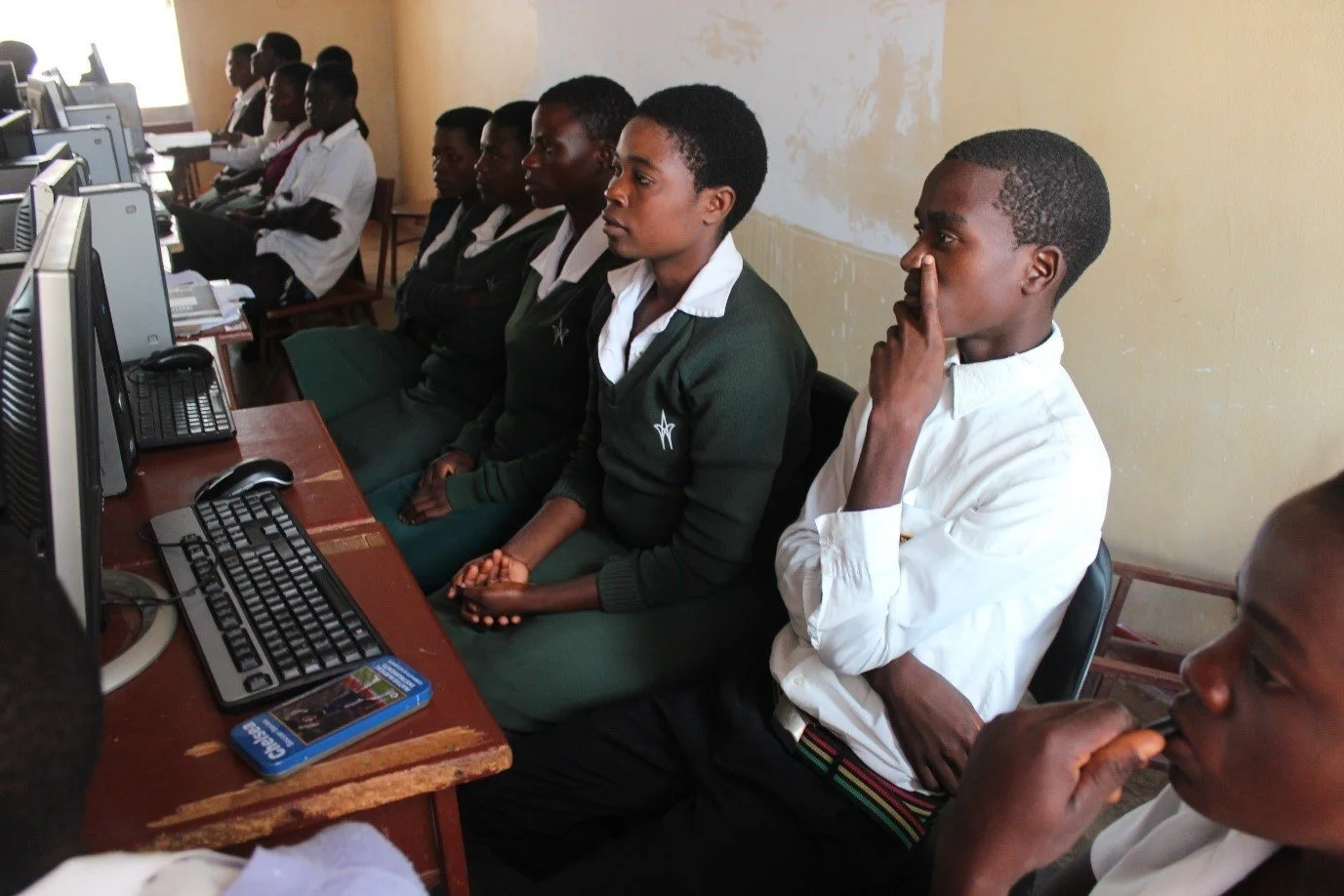Can school computers bridge the digital divide?
Earlier this year, we were delighted to host an inspiring graduate researcher whose independent study provides valuable academic insights into our work in Malawi.
Nat Chutima Tantakasem is now an MSc in International Development graduate from the University of Edinburgh where she attended as a Chevening scholar. Her dissertation ‘Bridging the digital divide: A study of an ICT in Education program in Malawi’ was based on her placement with the Turing Trust and the Malawian partner, Center for Youth and Development (CYD). She carried out ethnographic fieldwork in Malawi in May and June 2019. Her research examines the intersection between technology-enabled education, social equality and digital inclusion.
Why school computers and the digital divide?
The basic meaning of the digital divide is inequality in digital access and skills. By reusing computers from the UK in schools in Malawi, the Turing Trust and CYD aim to bring digital literacy to every student, bridging the digital divide by improving access to ICT.
The ICT in Education project shares the UNESCO’s vision that technology can facilitate universal access to education, enhance the quality of learning, bridge learning divides and strengthen inclusion. It responds to the Sustainable Development Goal 4: Ensure inclusive and equitable quality education and promote lifelong learning opportunities for all.
School computers bring students in Malawi closer to the vast amount of information in the digital space, opening up their access to the same educational resources as students anywhere in the world.
ICT access and skills remain a challenge in Malawi. The country ranks at the 167th place among 176 countries in the global ICT development index. Using the project in Malawi as a case study, this empirical research evaluates the impact of an ICT in Education program on the digital divide in a context of poverty and scarcity. It aims to answer the research question: How does the ICT in Education project correlate to bridging the digital divide between secondary school students in Northern Malawi?
What are the challenges of the project?
The project recently installed a computer lab in its 44th school at the time of this study. However, the initial goal, a bit over 3 years earlier, was much more ambitious – 4000 computers in 200 schools within 3 years.
It was not the shortage of computer donations. They could find 4000 computers. The challenges, in fact, were structural factors.
Previous studies and M&E reports have pointed out the problems; lack of electricity and infrastructure, shortage of ICT teachers and qualifications, weak ICT policy and governmental support, scarcity of technical resources and services, among others. All of these are structural factors in the broader social context.
The project found out there were much more to do than giving computers. The computer – ICT device – is one component in the bigger socio-technical ecosystem. Successful deployment has technical prerequisites; electricity, network and built infrastructure, as well as social foundations; ICT skills for teachers, repairs and maintenance services, software and content development.
Why does the context matter to the digital divide?
The structural forces in the context affected the digital divide at both levels; physical access and level of digital literacy.
Digital access
Over 80% of the schools are not able to join the program mainly due to lack of electricity and funding to build a secure computer lab. Electricity access in Malawi only reaches 13% of the population, whereas the global average is 89%.[i] An extra building is a significant investment in schools where classrooms are generally overcrowded or even non-existent.
ICT access is handed first to those in schools with basic infrastructure. Students in off-grid schools, mostly in poorer and more rural areas, are further left behind.
Digital skills
Among the schools with computers, the quality of education varies between private/public schools, urban/rural locations, social and economic status. Computer use depends on the school’s intent and capacity. Most schools face difficulties to recruit and retain ICT teachers with qualifications and skills. When ICT access is rare in society, the rarer it is to find ICT skills with teaching talent and motivation.
Despite having the same computers, different ICT education resulted in different level of digital skills. Students in private/urban schools with qualified teachers and well-organized curriculum can benefit more than their counterparts in public/rural schools with scarce resources.
The digital divide is exemplified at different levels. It is driven by the social and economic divides that already exist in the context. Technology, without addressing human foundations, can exacerbate the gap between rich and poor, private and public, urban and rural schools.
Why is this happening?
Technology is not good or bad, nor is it neutral. Technology is only a tool, by itself, to amplify human forces and magnify institutional intent and capacity, which can lead to positive or negative impacts. Humans drive technology, not vice versa.
Giving technology is not enough to achieve the goal – bridging the digital divide – but only solve the shortage of computers, a sign of poverty. Instead, technology faces the structural forces that show the bigger symptoms of poverty and inequality, the main problems that it had promised to solve.
The project in Malawi acknowledges that giving computers to schools is not enough, and that human efforts are required. In fact, the project is composed of 4 components; computer installation, teacher training, educational software, maintenance services.
However, the ambitious goal to bring digital literacy to every student often creates a dilemma: go installing computers in a new school VS repair computers and train teachers in an old school. In the face of scarce resources and pressure to deliver numbers to donors, the first option tends to win.
The way forward: What should be our priorities?
For technology to benefit the poorest and least privileged, it requires exactly the human foundations that is absent. A small NGO cannot work alone. The human foundations need to be a collaborative action from multiple stakeholders – governments, donors, schools, teachers, students, communities.
At the level of digital access, basic infrastructure and public goods require significant investment and political will at the high level. The prerequisites of ICT ecosystem remain largely missing; electricity, school buildings, ICT skills for teachers, ICT policy framework and implementation. The project will have to continue working on advocacy and partnerships.
At the level of digital skills, schools already with computers should become the priorities. Quality is more important than quantity, this is the opinion of students, teachers, and NGO staff on the field. Among students from the poorest to the richest school, some of the problems are in common;
They want teachers who can provide guidance to make the most of the computers
They want more access to computers beyond ICT class to practice ICT skills
They say there are often computers that need repairs, because electricity is instable and the computers are old, so they usually have to share among more students
Several NGO staff echoed wishes to deliver more quality in each school. To achieve the goals, the relationship between project staff and schools have to be more rigorously maintained by human presence, for teacher training and technical support.
When quality is the priority, it will lead the way to transformative change. Change does not happen overnight. Quality is harder to measure and deliver quantitative figures in the short term. Nonetheless, it is time for development donors to shift resources and perspectives to the needs of the context.
Key takeaways: What are the implications of this research?
In a world increasingly driven by digital technology and new innovations, the hype can both make us hopeful and fearful of how Artificial Intelligence and robotics may change our lives. On the contrary, strong human foundations matter now more than ever. Social change is less about what technology can do, but much more about what humans can do using technology and how to empower these human forces.
It is much easier to distribute 10,000 computers than to provide real education for 100,000 students, but the computers will only sit in a dark corner collecting dust unless a human knows how to put it to use. Technology, in and of itself, cannot achieve the goal of ‘bridging the digital divide’. The potential benefits of technology can only become a reality with strong human foundations, a collaborative effort between multiple stakeholders – governments, donors, civil society, teachers, students.
Quality education and sustainable development are interdependent and have much in common. Giving quality education requires an investment of time and resources, a well-tailored curriculum, and a strong education system. Once the children grow up, however, they can become valuable human resources who will continue to contribute to sustainable development.
Author: Nat Chutima Tantakasem
To find out more, you can access the executive summary here, and the full dissertation here



